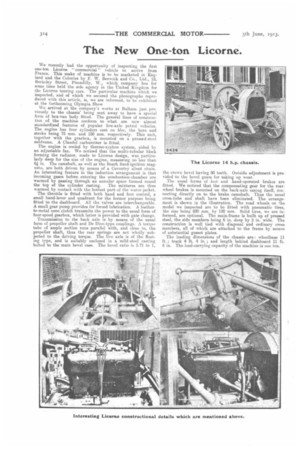The New One-ton Licorne.
Page 18

If you've noticed an error in this article please click here to report it so we can fix it.
We recently had the opportunity of inspecting the first one-ton Licorne "commercial" vehicle to arrive from France. This make of machine is to be marketed in England and the Colonies by F. W. Berwick and Co., Ltd., 18, Berkeley Street, Piccadilly, W., which company has for some tune held the sole agency in the United Kingdom for the Licorne touring cars. The particular machine which we inspected, and of which we secured the photographs reproduced with this article, is, we are informed, to be exhibited at the forthcoming Olympia Show
We arrived at the company's works at Balharn just previously to the chassis' being sent away to have a special form of box-van body fitted. The general lines of construction of the machine conform to what are now almost standardized features of popular live-axle petrol vehicles. The engine has four cylinders cast en bloc, the bore and stroke being 75 mm. arid 150 mm. respectively. This unit, together with the gearbox, is mounted on a pressed-steel subframe. A Claudel carburetter is fitted.
The engine is cooled by thermo-syphon system, aided by an adjustable fan. We noticed that the multi-tubular block forming the radiator, made to Licorne design, was particularly deep for the size of the engine, measuring no less than in. The camshaft, 045 well as the Bosch fixed-ignition magneto, are both driven by means of a Coventry silent chain. An interesting feature in the induction arrangement is that incoming gases before entering the combustion-chamber are warmed by passing through an annular space formed round
the top of the cylinder casting. The mixtures are thus warmed by contact with the hottest part of the water-jacket.
The throttle is fitted with both hand and foot control, a small hand-lever and quadrant for the former purpose being fitted to the dashboard. All the valves are interchangeable. A small gear pump provides for forced lubrication. A leatherto-metal cone clutch transmits the power to the usual form of four-speed gearbox, which latter is provided with gate change. Transmission to the back axle is by means of the usual form of propeller shaft and De Dion-type couplings. A torque tube of ample section runs parallel with, and close to, the propeller shaft, thus the rear springs are not wholly subjected to the driving torque. The live axle is of the floating type, and is suitably enclosed in a mild-steel casting bolted to the main bevel case. The bevel ratio is 5.71 to 1, the crown bevel having 80 teeth. Outside adjustment is provided to the bevel gears for taking up wear.
The usual forms of foot and hand-operated brakes are fitted. We noticed that the compensating gear for the rearwheel brakes is mounted on the back-axle casing itself, connecting directly on to the brake camshaft. Thus the usual cross-tube and shaft have been eliminated. The arrangement is shown in the illustration. The road wheels on the model we inspected are to be fitted with pneumatic tires, the size being 820 mm. by 120 mm. Solid tires, we are informed, are optional. The main-frame is built up of pressed steel, the side members being 6 in. deep by 2 in. wide. The construction is well tied with diagonal and ordinary cross members, all of which are attached to the frame by means of substantial gusset plates.
The leading dimensions of the chassis are: wheelbase 11 ft.; track 4 ft. 4 in.; and length behind dashboard 11 ft. 6 in. The load-carrying capacity of the machine is one ton.


























